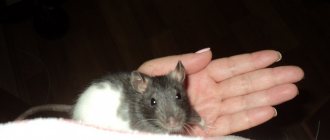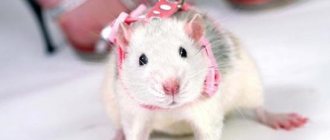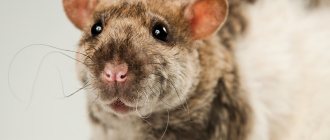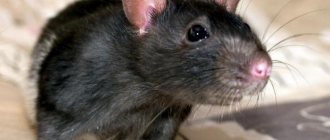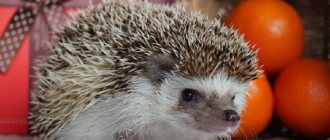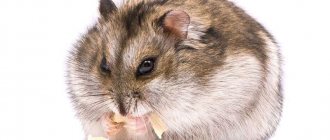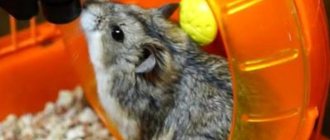- Wild animals
- >>
- Mammals
Contrary to popular stereotypes, a rat can be not only a minor pest and a carrier of especially dangerous diseases, but also a real pet, causing affection among all family members. Especially when it comes to ornamental animals! The Dumbo rat seems to be created to live with a person!
Appearance
Dumbo differs from an ordinary rat in his ears - they are low-set and quite large. Moreover, the larger the ears, the more valuable the representative of the breed.
There are two types of auricles:
- The saucer shape is flat and round.
- Bud shape - they have sharp tips and are slightly curled inward, which is why they resemble small flower buds.
Reference! Dumbo with bud-shaped ears are very popular in European countries.
Types of decorative rats
There are different breeds of decorative rats. According to the type of wool they are divided into:
- standard, with short and smooth pile;
- rexes with mustaches and wavy fur;
- satin - with shiny silky fur;
- sphinxes are naked rats;
- Dumbo - individuals are distinguished by round, low-set ears, reminiscent of Mickey Mouse.
Animal colors are divided into subspecies:
- homogeneous: there are pure black, white, chocolate, blue, albino and others;
- heterogeneous: rats have Siamese, Himalayan, sable, silver and other colors;
- variegated: composed of several colors.
Main characteristics
Dumbo differs from its relatives in the following parameters:
- Body. The body is shorter and stockier. The size of an adult varies from 16 to 21 cm, weight - from 240 to 410 grams. Males are noticeably larger than females.
- Head. Round, muzzle elongated and sharp.
- Wool. Color and structure are variable.
- Tail. By standard, the tail is long and quite thick. There are also tailless varieties.
Description of the animal
The Dumbo rat differs from the usual one in the fit and size of the ears. Its shells are much larger than those of its relatives and are set lower. Representatives of this breed have ears that are round, somewhat saucer-shaped, or petal-shaped. In the second case, they are elongated and have rounded ends.
The Dumbo rat is valued precisely for the size of its ears. The larger they are, the higher the cost of the animal.
The Dumbo rat breed was developed by American breeders in 1991. The animals came to Russia in 2001.
Appearance
The body size of the Dumbo rat is 15-20 cm. Males are much larger than females. The weight of a representative of this breed is 240-400 g.
Exterior Features:
- body is pear-shaped, stocky;
- the neck is short;
- wide head with a slightly protruding occipital part;
- elongated sharp muzzle;
- low set large ears;
- eyes look like beads;
- the tail is quite long, with a thick base (the breed also has a tailless variety);
- the coat can be smooth or curly, and there are also hairless representatives of the breed;
- Common colors are beige, gray, black, blue.
Character and habits
Dumbo rats have a friendly disposition. They quickly get used to their owner, willingly go to the hands and play. These are smart pets that can be trained to carry out various commands if desired.
Adults are more balanced and calm. Little Dumbo rats love active games. Experienced breeders advise buying pets at an early age. Then they quickly become tamed and grow up trusting and affectionate.
Health and life expectancy
Decorative rats, including dumbos, live 2.5-4 years. The health of a pet largely depends on the quality of care and nutrition. The owner must ensure that the animal receives all the necessary nutrients and vitamins and leads an active lifestyle.
Pet rats are susceptible to the following diseases:
- infectious diseases of the respiratory system – rhinitis, bronchopneumonia;
- tumors – the most common tumors in the brain;
- conjunctivitis;
- parasitic diseases.
Attention! Infectious diseases in rats develop rapidly. If help is not provided in time, the pet may die in 2-3 days.
It is important to learn to recognize the first signs of illness in an animal:
- tousled fur;
- discharge from the eyes and nose;
- lethargy, depression;
- loss of appetite;
- refusal of food and water;
- noisy breathing.
Animal character
Breeders identify three temperaments characteristic of Dumbo:
- Learning ability. With regular training, the rodent quickly becomes tamed and learns to perform simple tricks.
- Laziness. This point follows from the first - the rat quickly understands the cause-and-effect relationship “following the command - a treat” and becomes lazy if it sees that there will be no reward.
- Friendliness. Dumbo loves to spend time with his owner. They take the initiative to get to know other household members. However, if the owner spends a lot of time outside the home, the pet may get bored. Therefore, veterinarians advise having two same-sex individuals at once.
What do you name the rat Dumbo?
Look at your new eared pet, think about what you could call him? Perhaps his character and appearance remind you of some character from a fairy tale, book or cartoon? If you find it difficult to choose, then use our lists!
| Names for boy rats: | Names for girls: |
|
|
You can find out more about names in the article - What to name a pet rat?
Decorative rats - diseases
A healthy animal is always active, it has clear eyes and shiny fur. There should be no red spots around the rodent's eyes, nose and ears. Knowing what a decorative rat looks like when properly cared for in a healthy state, if abnormalities are detected, you should consult a doctor. Rodent diseases:
- Excessive tooth growth. Occurs due to insufficient grinding and using only soft food - a veterinarian can help.
- Mycoplasmosis. A bacterial disease, infection occurs through the air, leading to pneumonia. It is almost impossible to save the animal.
- Abscesses. Abscesses appear on the skin, the doctor opens them, treats them, and administers the necessary medications.
- Tumors. They can be benign or malignant; the decision to remove them is made by the veterinarian.
- External parasites are mites. Appear from an excess of protein foods. It is necessary to remove seeds, nuts, meat from the diet, and clean the home daily for 1-2 weeks.
Maintaining a sanitary regime and ensuring a balanced diet are the main conditions for proper maintenance and care of the animal. Some infectious and parasitic diseases are also dangerous for humans, so you need to monitor the behavior and appearance of the animals and maintain personal hygiene. If your pet has lost its appetite, become less active, or looks unusual, it is important to contact a veterinarian.
How to tame a decorative rat?
Decorative rats have pros and cons in their character. The first include openness to communication and intelligence. As soon as a little rat appears at home, he is immediately given a name and addressed to him when food is poured in. After three days, the rodent begins to respond to the nickname and recognize the owner. Then you can gradually accustom him to holding hands. After the animal finally gets used to its owner, it is released to walk around the apartment. The disadvantage of a pet is the desire to chew on something - this must be controlled.
What varieties are there?
As a result of selection, the following notable subspecies of Dumbo rats were obtained.
Rex
The body is covered with curly, dense hair. In young rats, the hairs stick out funny in different directions, as the curls are just forming. In some cases, even the mustache curls.
A healthy individual has no bald spots or bald spots on the body - the hair evenly covers the entire body. The skin is soft and plush to the touch.
Reference! Dumbo Rex is a subspecies that has not yet been included in the breed standards.
Sphinx
Just like cats of the same breed, Dumbo Sphinx rats are completely hairless. Their skin is soft, velvety, folded. The mustache may be short, curled, or absent altogether.
Due to their peculiarity, they often injure the skin and contract infectious and viral diseases. If you are planning to get two rats at the same time, then keep in mind that only their breed can be added to Sphynxes.
Other rats may be quite aggressive towards them, due to the specific appearance associated with the disease.
Siamese
The fur on the body is a delicate, light cream color, and the muzzle and paws are outlined in dark brown. The gene for this color is recessive, so it is passed on from generation to generation quite rarely. This explains the high price for baby rats.
Husky
Dumbo Husky rat pups are born in a completely standard color: brown, gray or black. Only with age do the snow-white hairs characteristic of this color begin to appear on the fur coat.
Manx
Breeders still treat this subspecies rather coldly and oppose the breeding of such individuals. The fact is that the absence of a tail in Dumbo-Monx is a consequence of a complex mutation. Taillessness for a rodent means a loss of balance and the inability to cool the body in moments of overheating.
Manx often have serious problems with the musculoskeletal system, due to which they rarely live to be a year old.
Blue
The Blue Dumbo has a light gray coat with a noticeable bluish tint. It is quite rare, which is why breeders often raise the price of rat pups.
Origin of the species and description
Photo: Dumbo Rat
A few words about how this breed was formed in general and thanks to which it gained worldwide popularity. The name of the decorative rat of the Dumbo breed is explained by the similarity of this animal with a cartoon elephant calf. Moreover, initially the name “dambo” was unofficial, “folk”, which was assigned to decorative rodents by their first owners. Off we go, and when the breeders decided to officially register the new species, no one had any questions regarding its name.
Video: Dumbo Rat
There is no exact date for the formation of the species - for the first time, “dambiks” appeared among private individuals (as pets - they were used in laboratories before that) in the USA in the early 90s. Then the fashion spread to Japan and China - there, in general, such rodents have always been highly revered, and the novelty in the form of “dambies” successfully supplanted the familiar hamsters. Well, in the late 90s, the fashion for decorative rats also appeared in Russia, and domestic zoologists developed several new breeds of this animal.
Interesting fact: The Dumbo rat breed is considered artificially bred. Yes, in nature there are rodents similar to dambiks, but they have a number of significant differences. Despite the fact that they can easily interbreed with each other and produce offspring capable of reproduction, they cannot be classified as one species.
So even if you have never kept a pet, do not be afraid - the Dumbo rat is considered one of the best options for the first animal that a person decides to place in his own living space. The catchphrase “you come home and she’s happy to see you” is clearly about the Dumbo rat. People who have never had a decorative rat before do not even suspect how affectionate, intelligent and responsive these rodents are. Smart and sociable rodents get used to their owners no worse than dogs and cats. Fluffy rodents “will not require” a significant living space, they will not have to undergo difficult specific care and spend money on purchasing expensive food.
Is it worth getting Dumbo the rat as a pet? Advantages and disadvantages
A pet rat can be a full-fledged four-legged friend. To understand whether such an animal is right for you, you should weigh all the advantages and disadvantages.
Pros:
- can be kept even in small housing;
- have a friendly disposition;
- clean;
- don't make noise;
- maintenance does not require large financial costs;
- easy care.
Minuses:
- without regular tactile contact with humans, rats may never be tamed;
- not suitable for people who spend most of their time at work, as animals need communication;
- cats and dogs can attack a rodent due to their hunting instinct.
Breeding
Puberty in Dumbo rats occurs at six months of age. However, there is no need to rush to crossbreed the female. Her body must be fully formed. It is better to wait a month or two, and then place the female with the male in order to obtain offspring.
Pregnancy lasts 21-23 days. There are from 6 to 12 cubs in one litter. Some dumbo rats have regular-sized ears, but when they become adults, they can give birth to long-eared offspring. The animals are born completely bald, blind and deaf. The mother feeds them with milk for 3 weeks.
Dumbo rats grow quickly. After four days, the babies begin to see. The rumor appears approximately on the 12th day after birth. Within 2 weeks, their bodies are covered with soft fur. At this age you can already pick them up. The right time to transfer dumbo rats to new owners is one and a half months.
The gender of a rodent can be easily determined by its nipples. In females they are located along the abdomen in two rows. Males do not have mammary glands.
The Dumbo rat is an ideal pet that does not require a lot of money to maintain. One of his undeniable advantages is his friendly character and strong affection for people. A funny animal can bring a lot of joy to its owner.
Dumbo - what to feed?
In most cases, breeders give preference to ready-made feed mixtures of grains, nuts, and bran. But this does not mean that the pet does not need additional feeding. To replenish protein reserves, she can be given boiled chicken fillet, liver or heart. Fresh apples, peaches, bananas and cherries are good treats.
Important! Do not give your rodent dried fruits - they contain too much sugar.
Many inexperienced breeders often feed rats from the table, believing that this will not harm their strong immunity. This is a dangerous misconception! Foods that are too fatty, salty, spicy or hot can cause indigestion, bloat, and even death.
Knowing this, you should exclude from your diet:
- fatty meats and fish;
- baked goods, confectionery products;
- cheese;
- cabbage;
- radishes, horseradish, turnips;
- raw and fried potatoes;
- artichokes;
- all legumes;
- mushrooms.
The rats are fed 2 times a day - morning and evening. Adults twice as often. It is important to ensure that your pet always has clean drinking water.
In limited quantities, dairy and fermented milk products and citrus fruits can be given as treats.
Features of feeding
Dumbo rats are omnivores, but there are still some dietary restrictions. Pets are prone to allergies and, unlike their wild counterparts, sometimes suffer from digestive problems.
The basis of the diet of the dumbo rat is grain. Pet stores sell special food for small rodents, which includes:
- millet;
- barley;
- buckwheat;
- lentils;
- nuts;
- herbal granules;
- raisin;
- sunflower seeds;
- pumpkin seeds.
In addition to grain, Dumbo rats are fed boiled lean meat, offal, cottage cheese, and eggs. Rodents are not averse to eating vegetables and fruits. They love to eat carrots, broccoli, zucchini, cucumber, as well as apples, bananas and peaches.
Dumbo rats can be given fresh greens as an additional source of vitamins. The pet will like the leaves and shoots of dandelion, plantain, dill and wheat sprouts.
Not all food will benefit your pet rat. Many foods from the human table can harm the health of the animal. These are salty, spicy, fried, fatty foods.
Prohibited products include:
- semi-finished products;
- sausage, frankfurters;
- canned food;
- snacks;
- peas and beans;
- sweets;
- baking;
- fish;
- pork;
- vegetables - white cabbage, horseradish, radish and turnip;
- mushrooms in any form;
- cheese.
Dumbo rats can only drink filtered water and milk. Sometimes you can pamper your pet with low-fat kefir. There should be no sweet drinks in your diet.
Care and maintenance
In order for a pet to feel comfortable, it must be provided with appropriate living conditions.
Cell
The best solution for housing is a spacious, multi-story metal cage. When purchasing, make sure that it does not contain wooden or metal fittings, as a rat will quickly chew through it.
First of all, you need to decide how many animals you will have. As stated earlier, the minimum is 2 rats. The minimum dimensions of the cage are height 50 cm, length 60 m, width 40 cm.
For temporary housing (mooring a sick animal, etc.), smaller cages can be used.
The width of the rods should be less than 2 cm, otherwise the animal will simply squeeze through and run away.
Place to sleep and relax
The house should be quite large so that the rat can completely hide in it and lie down comfortably. The preferred material is durable, thick plastic. It does not absorb odors, is easy to disassemble and clean.
A hammock is a suspended structure made of soft fabric, closed or open, in which a rodent can hide from the cold and prying eyes.
Many rats willingly doze in hammocks, which looks extremely funny, but, unfortunately, this design is very short-lived and quickly absorbs the smell of the cage. It is better to have several in reserve, while one hammock is in the wash, the animal sleeps in the other.
Important! If several rats live in one cage, each of them should have its own house or hammock.
Drinking bowl and other utensils
The most preferred material for bowls is thick ceramic. Such a plate is difficult to turn over, and it does not make noise when the pet is sorting through the food. There should be 2 bowls - one for industrial food, the second for complementary foods in the form of vegetables, meat and fruits.
If there are two Dumbo rats living in a cage, purchase a long bowl with bars attached, or place a large plate in the center of the cage. This will allow pets to eat freely without disturbing each other.
As for drinkers, the most preferable option is a ball drinker with a grate attachment. This design allows you to keep water clean and fresh for a very long time. The downside of this type of drinker is that it makes a lot of noise, and the ball can get stuck inside the tube.
Toys
The rat, unlike other pets, is not allowed to roam freely around the house. But sitting in a cage all the time can lead to obesity and mental problems.
To prevent the animal from getting bored, place ladders and ropes inside the cage. Special pipe labyrinths for rodents are also good. They can be purchased at a pet store or made yourself.
Keeping decorative rats
Domestic decorative rats are rodents; they are cared for and kept in metal cages, because they are the strongest and most durable. It is better not to keep animals in plastic and wooden structures. It is also not recommended to place them in aquariums - they are difficult to clean, and the animals jump to a height of 40-50 cm and can escape. The house is installed in a place where there is no direct sunlight and draft, from which a rat can contract pneumonia. There is no need to place a home near the battery - dry air is harmful to animals. Optimum temperature +18-20°C.
For a decorative rat, the cage should have a size of 60x40x30 (for growth); often the house has two floors. Inside the home you need to install:
- a plastic tray with filler (preferably dry wood granules. Small sawdust can cause allergies in rats by getting into their eyes and nose. Newsprint contains harmful substances and is not suitable for use as bedding);
- stairs and tunnels, a wheel (animals love to play);
- plastic house for privacy;
- mineral stone for rodents (they sharpen their teeth);
- drinking bowl;
- 1-2 bowls;
- a cloth for sleeping or a hammock.
How to maintain hygiene?
Dumbos are very clean and take good care of their coat. Once every six months, you can bathe your pet to get rid of the specific rodent odor. In this case, it is better to use a specialized shampoo.
Teach your pet in advance to the feeling of water on his skin so that bathing does not become stressful for him. Do this in a playful way: let your pet try to get a toy or treat from a bowl with warm water at the bottom. Pleasant associations will allow the animal to calmly undergo hygiene procedures.
Note! You need to change the filler in the cage at least twice a week!
Features of character and lifestyle
Photo: Decorative rat Dumbo
The character of Dumbo rats is quite friendly - these affectionate and very trusting rodents quickly get used to their owners, remember their nickname and are easy to train. There is also the “other side of the coin” - dambiks get used to only one owner, so you only need to buy babies. A change of owner for an adult Dumbo rat can cause severe “mental trauma” and associated psychosomatic illnesses.
Young dumbo rats are much more active than their relatives. Animals love to play with humans and other animals (unless, of course, they are cats or dogs). It will be much more pleasant for adult rats to simply lie on the lap or sit on the shoulder of their beloved owner. Cleanliness is a special feature of these animals. They scrupulously monitor their cleanliness and quickly become accustomed to the litter box (read above on how to develop this addiction).
The lifespan of dambiks is 2-3 years. It is noteworthy that it is directly proportional to the quality of housing and feeding conditions. If decent care is provided, systematic examination and timely treatment of diseases, as well as feeding a properly selected, balanced diet (including greens), the life of Dumbo rats is extended to 4-5 years.
Interesting fact: Dumbo rats are very clean - they always reserve only one corner of their home for relieving themselves. Accordingly, you need to place a tray with filler there. It will not be difficult for a smart pet to understand the purpose of this “accessory”.
Microclimate. The cage with the little rat should be installed in a dry, warm room. The minimum distance from the floor is 1-1.5 m, subject to maximum distance from sources of bright, blinding light and electromagnetic radiation. Your furry friend should be protected from exposure to adverse factors. Under no circumstances should drafts, overheating and cooling, as well as sharp sounds or intrusive attention of people and animals be allowed. You will need to systematically remove food debris and used litter from the cage, and change the water twice a day. Disinfection of a rodent's home should be carried out at least 2 times a week.
Hygiene. Dumbo rats diligently wash and clean themselves every day, but you can bathe your pet periodically - unlike most other pets, Dumbo rats are very fond of water treatments. Trimming small claws should be a regular procedure.
Reproduction and offspring
Dumbo reaches sexual maturity at 6 months - this is when mating can begin. Pregnancy lasts from 21 to 23 days. A female can give birth to 8 to 15 rat pups - they are born blind, deaf and completely naked. The distinctive feature of large ears is not found in all cubs.
Animals develop quite quickly: the fur on their body begins to appear from the first days, on the fourth day they begin to hear, and at two weeks of age they begin to see.
At 15 days, the pups begin to independently explore the world and get to know people. At three weeks the babies eat food, and at 1.5 months they are completely ready to start life with their new owners.
Training Basics
Small and cunning Dumbos are happy to follow simple commands in order to get a treat. But you should not force the animal to perform complex tasks from the very first days. Start with the basics:
- Get your rat used to being handled. This step is the most important, but the most exciting for new rat breeders. Do not make sudden movements, do not grab or squeeze the rat - it may get scared and bite you. Calmly extend your open palm to the animal and let the pet know that you do not pose a danger to its life. You need to devote at least 2 hours to this every day.
- Learn to respond to a name. Every time you open the cage, pick up the rat, pet it or give it a treat, say its name clearly. Do not use diminutives and do not go through different nicknames. The animal must build a clear association between the sounds being spoken and the result obtained.
- Train your rat to return to the cage. You should move on to this step when the animal clearly remembers its name. Open the cage, step back a few steps, give your pet a treat and call him over. Let your pet run up and take the food from your hand. Allow him to return to the cage on his own, and when she enters, say the command “home!” After a few repetitions, Dmbo will learn to come home and leave the cage on command.
Today it is difficult to surprise anyone by keeping unusual pets in an apartment, and more and more people are looking for an alternative to the usual cats and dogs. Dumbo rats are an excellent option for those who want to get a smart and entertaining pet that does not require large financial outlays.
Great article 40
Their morals
Like all rats, Dumbo is smart and quick-witted. In the house it takes on the role of a cat - it becomes attached to the owner, loves to nap on his lap. Rodents value communication, affection, and willingly learn various tricks. Get along with four-legged animals. They come running when called, even if the name is a cat or a dog - what if they give them something tasty, but they will be left out of work. But a small thing like a turtle or a parrot can casually gobble it up if it doesn’t show up. Let him know that he is dealing with a predator. The level of intelligence allows you to catch fish from the aquarium. Shows remarkable dexterity - as soon as the owner gapes, a piece of sausage disappears from the kitchen table instantly.

